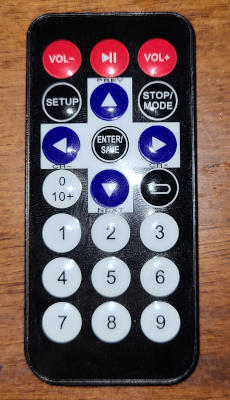 Robodrome
Robodrome
 Wheeled Robot "Neumann"
Wheeled Robot "Neumann"

Originally Created: 2023-08-31
"Neumann" Redesign Completed: 2025-07-25
A robot with two independently controlled wheels, light up eyes, a piezo beeper, and an IR remote. The frame, shell, and wheels are 3d-printed. The clear dome is a found object. The remote allows programming in the same fashion as the classic Big Trak.
 "Neumann" Redesign
"Neumann" RedesignI was never entirely happy with the original shell design of this robot. After making the Raygun, I had a lot more metallic red filament left. So I decided to redesign the robot's shell, making it more elaborate, humanoid, and retro.
I modeled the head on
Garco  , a life-sized robot that famously appeared on TV with Walt Disney! The
body is loosely inspired by skirted toy robots from the 60s. The
interior of the clear dome is a much simplified take on the
Lost in Space Robot's "brain".
The dome itself is half of a capsule from a vending machine at a local
comics and games store.
, a life-sized robot that famously appeared on TV with Walt Disney! The
body is loosely inspired by skirted toy robots from the 60s. The
interior of the clear dome is a much simplified take on the
Lost in Space Robot's "brain".
The dome itself is half of a capsule from a vending machine at a local
comics and games store.
The new design is named "Neumann" for the influential paper on programmable computers written by John Von Neumann.[1] Read on to find out why!
 New Programming
New ProgrammingIn addition to the new shell, I overhauled the firmware. I had always considered adding Big Trak-style programming to this robot, and I finally committed to it. The Big Trak used different units for different functions, but to simplify things, each of the commands here is given a duration in tenths of second. (Except for Repeat.)

| Vol- | Play/Pause | Vol+ |
|---|---|---|
| Nothing | Run Program / Abort | Repeat # Commands |
| Setup | Up Arrow | Stop/Mode |
| Delete All | Go Forward | Pause |
| Left Arrow | Enter/Save | Right Arrow |
| Turn Left | Test Last Command | Turn Right |
| 0 / 10+ | Down Arrow | Looping Arrow |
| (See below) | Go Backward | Delete Last |
| (Remaining buttons are numerals for entering the duration of the command) | ||
The video from above again. You can see a candid programming session.
 (mp4)
(mp4)
 Original Version
Original VersionA robot with two independently controlled wheels, light up eyes, a piezo beeper, and an IR remote. The frame, shell, and wheels are 3d-printed. Functions on the remote are: forward, backward, turn right, turn left, stop, and beep.
 Inside
InsideMost of the electronics are mounted to a 3d-printed frame. The body shell fits over it, and the LED eyes and IR receiver plug into the main board. The robot is powered by two removable NiMh D Cells. A MakerDrive board provides power and motor control. An Adafruit ItsyBitsy AtMega32U4 microcontroller board controls it.

[1] I am aware most of the actual work was done by other people, but the name "Von Neumann Architecture" has stuck. He was a genius in his own right, and worth honoring anyway.
© 2025 Kyle Delaney | Site Map